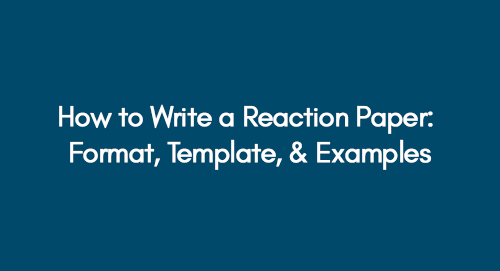
100+ Correlational Research Topics
May 11, 2024A reaction paper is a written response that allows you to express your thoughts, feelings, and analysis in response to a specific text, article, book, movie, or other media. It is designed to encourage critical assessment and sharing of individual thoughts, feelings, and perspectives rather than simply providing a summary.
Learn How to Write a Research Project
Here, you will find a complete guide on how to write reaction paper, its format, template, examples, and what key elements must be included in a quality reaction paper draft.
Example: Review English Dissertation Examples
How to Write a Reaction Paper: Key Elements
When writing a reaction paper, it's important to include key elements that will help you clearly express your thoughts and opinions.
Summarise the Text
Before you start sharing your own thoughts and feelings, it's important to first provide a simple and clear overview of the key points, arguments, and themes in the text you are responding to. Stick to the most important facts and avoid adding your personal opinions.
Express Your Reactions
Feel free to express your thoughts using "I" to share your opinions and feelings. Explain what you agree or disagree with and why, using specific examples and quotes to support your reactions.
Analyse the Text
Let's take a deeper look at the information. Think about whether the arguments are convincing. What assumptions and preexisting beliefs do you notice? How does this information connect to what you already know? Feel free to share your thoughts and perspectives as you analyse.
Compare and Contrast
Comparing the text with other things you've read or experienced can help you understand it better and think critically. It's important to explore similarities and differences and consider how the text changes or adds to your understanding of the topic.
Conclusion
In your response paper, summarize the key points you discussed and share your overall thoughts and analysis. Talk about why the text is important and what you learned from it. End with a strong statement that makes the reader think.
Format of Reaction Paper
To effectively share your thoughts and insights about a text, it's important to include certain elements and stick to a clear format. This reaction paper sample format guide helps to organise your ideas and make your writing easy to follow.
Title Page
Start your paper off with a title page that includes:
- Title of your reaction paper
- Your name
- Course name and number
- Instructor's name
- Date
Introduction
Start with a brief introduction that includes a condensed summary of the text you are responding to, such as its title, author, and main ideas. Your thesis statement is like the main point you want to make in your writing. It's the central argument or your primary reaction to the topic you're discussing.
Summary
Please offer a brief summary of 1-2 paragraphs, highlighting the main points, arguments, and themes in the text. Please keep it factual and avoid using opinionated language.
Analysis
The most important part of your paper is the analysis section where you break down your reactions and opinions. Organize your analysis into separate paragraphs, each focusing on a specific point. Use the "They say / I say" format, which involves describing an idea from the text ("They say"), stating your reaction and analysis ("I say"), and providing textual evidence to support your viewpoints.
Conclusion
Conclude your paper with a brief paragraph that restates your key points and reinforces your thesis. Additionally, reflect on the importance of your response and provide any acquired insights.
References
If external sources are cited, a references page should be included at the end, following the appropriate citation style (APA, MLA, etc.).
Formatting
Remember to use a double-spaced format with 12pt Times New Roman font, maintain 1-inch margins on all sides, number pages in the top right corner, and indent paragraphs by 0.5 inches.
Reaction Paper Example: "The Impact of Social Media on Society"
Introduction
In this sample reaction paper "The Impact of Social Media on Society" by John Smith, the author talks about how social media has affected our lives, relationships, and behaviors. This reaction paper will look at the main ideas in the article and share personal thoughts and reactions to the topic.
Summary
Smith talks about how social media has changed the way we communicate, bringing people from all over the world closer and making it easier to share thoughts and information. He also points out the bad things about social media, like cyberbullying, privacy worries, and the spread of false information. The article stresses the importance of being careful about what you do and say online and using social media in a responsible way.
Analysis
I came across an article by Smith discussing how social media can affect our mental health. The article talks about how spending too much time on social media can make us feel like we're not good enough, anxious, and even depressed. I could relate to this because I've felt pressured to show only the best parts of my life on social media. Smith's ideas made me think about how social media impacts me and made me want to be more careful about how I use it.
Synthesis
Smith's article agrees with other studies I've come across about social media and how it affects society. It supports the idea that while social media has its good points, it also has some serious downsides that we need to deal with. By combining this info with my own experiences, I can see how important it is to find a balance between using social media to connect with others and being careful of its possible bad effects.
Conclusion
After carefully reading "The Impact of Social Media on Society" by John Smith, I've gained valuable insights into how social media affects our lives. This paper has helped me think deeply about the main ideas in the article and consider how I personally use social media. Going forward, I'm dedicated to using social media thoughtfully and carefully, understanding both its advantages and its possible drawbacks.
FAQ's
Final Thoughts
A reaction paper is a way to express your thoughts and feelings about articles, books, or movies. It encourages critical assessment and sharing of individual perspectives. By following a structured format, you can effectively craft an engaging and insightful paper. Remember to maintain clarity, support opinions with evidence, and adhere to formatting guidelines. Through examples like the impact of social media on society, a reaction paper allows for reflection and personal growth.
Get 3+ Free Fashion Dissertation Topics within 24 hours?



























